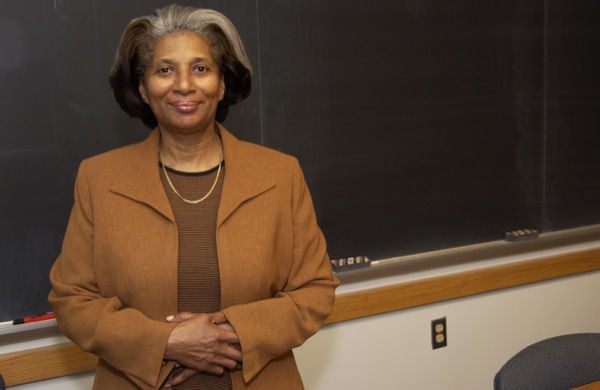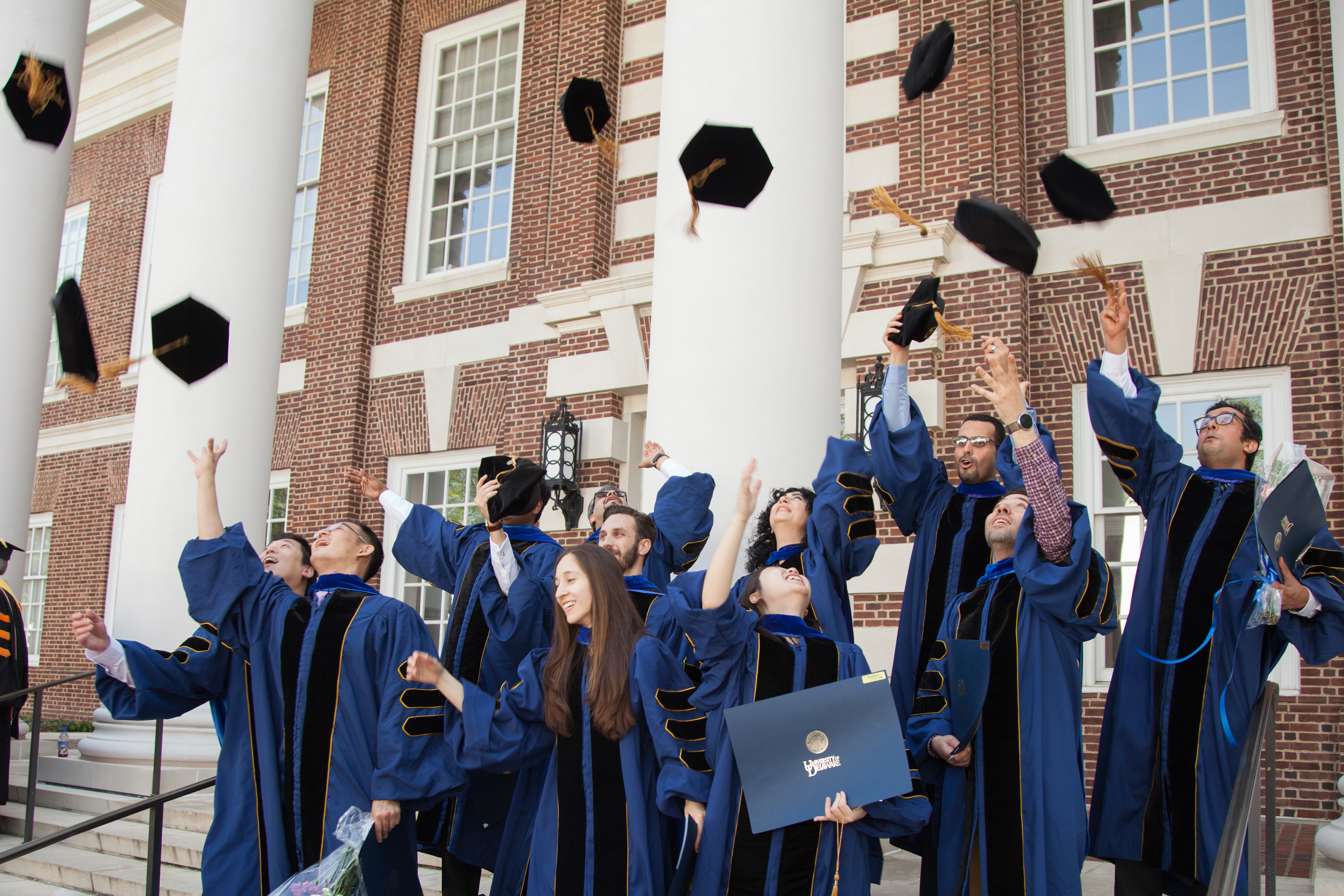
Blueprints for growth
UD Blueprint Communities partnership helps communities in need
9:44 a.m., Dec. 12, 2013--For Javier Paula-Bouldin, what did it for her was the day an elderly resident in her community, stricken with cancer, was slapped with fines for failing to properly maintain his home.
Paula-Bouldin — a business owner with an engineering degree, a mother of two and a civic activist — got to work in her New Castle community of Simonds Gardens. She knew many of its residents were older and on fixed incomes; home repairs were a challenge.
Campus Stories
From graduates, faculty
Doctoral hooding
Two years ago, she became the leader of her Blueprint Community team, an initiative of the Federal Home Loan Bank (FHLB) of Pittsburgh in partnership with the University of Delaware’s Center for Community Research and Service (CCRS), and worked tirelessly to figure out how to help her neighbors.
Simonds Gardens recently celebrated efforts to revitalize more than a dozen homes. The Blueprint team, in partnership with Habitat for Humanity of New Castle County, helped low-income homeowners complete everything from roof repair to house painting and installation of new shutters, mailboxes and gutters over the course of the last year.
“To see their accomplishments … is just extraordinary,” said Raheemah Jabbar-Bey, assistant professor in the School of Public Policy and Administration and co-principal investigator with Steven Peuquet, director of CCRS, of the Blueprint Communities Delaware Program.
The FHLB of Pittsburgh started the program in 2005 to help neighborhoods, communities, cities and towns in Pennsylvania and West Virginia achieve their goals of thriving and growing sustainably. The bank approached CCRS in 2007 about formalizing a Delaware partnership.
“We were very honored the bank’s vice president and director of the department of community development understood and valued the work the center has been doing for [over] 40 years in community development, housing, nonprofit management and community engagement,” Peuquet said.
The center manages Delaware’s Blueprint Communities and provides teams with the training and technical assistance they need to come up with plans. Faculty, staff and UD graduate students in CCRS work with the teams as they plan and implement their projects.
Simonds Gardens became certified as a Blueprint Community in 2008. Once its team was established, it got to work surveying residents, holding focus groups and developing plans. Paula-Bouldin said these plans include creating programming for youth, promoting community advocacy and improving homes.
The team has changed shape several times over the last several years, Jabbar-Bey said, yet it has been successful at drafting plans representative of the community’s needs.
Civic leaders in Simonds Gardens had already been working to help their neighbors. But Paula-Bouldin said the waiting list of people in need was growing. There was more work to be done than the community could achieve on its own.
The community applied last year for a mini grant to complete some of the work, she said, and was disappointed when that grant was not awarded.
However, it was soon uplifted to learn its housing revitalization plan was competitive for an even larger award through the FHLB of Pittsburgh’s Affordable Housing Grant. But first, residents needed a larger nonprofit partner.
“We ended up partnering with Habitat for Humanity, which was only in Wilmington at the time,” said Paula-Bouldin. “And we won a big check.”
The beauty of their proposal, Jabbar-Bey said, was that the Blueprint team and civic association had already been active in the community.
“They knew a lot of the seniors were on fixed income and had helped replace some gutters and sidewalks,” she said. One requirement of a Blueprint Community is that it show the capacity to get work done and have a strong foundation of local leadership.
The grant of $56,000 was awarded last December, and Habitat matched it. The community went to work, quickly, and completed the project in less than 12 months.
“It was one of the best experiences ever,” said Paula-Bouldin, in spite of the longs hours and endless phone calls and emails her role has entailed. “We went from total strangers with an idea of what to do, to bringing it full circle. It created such a warm feeling.”
And she said the recent work brought the community together. Those with skills and talents put them to good use, donating their time and abilities. Local roofing companies and others donated time and materials.
Other neighbors, inspired by the efforts, began improvements of their properties, too. The community has nearly 250 homes, most of which were originally built in the 1950s for veterans of World War II.
Notes taken at the celebration Nov. 15 by CCRS graduate student Hannah Beesley, who helps coach the team, show the work was profound for the residents it served.
It “changed me and my family life forever,” said homeowner Conceleta Berbick. Another resident was thrilled to have a mailbox for the first time, and another felt safer after a new fence was installed in her backyard to prevent people from traipsing through it.
There are currently seven Blueprint teams throughout the state, including Edgemoor, Wilmington’s Browntown and Eastside communities, and Georgetown.
For Jabbar-Bey, seeing another successful project is inspirational and confirms the work CCRS is doing. On Nov. 12, Wilmington’s Eastside celebrated a commitment to completely renovate and rehabilitate 125 homes over the next five-to-seven years and make them available for current renters and new homeowners.
Jabbar-Bey said, “If this doesn’t show their growth and development and their capacities … for two Blueprint teams in one week to demonstrate such monumental accomplishments — positive change can happen that is community- and stakeholder-driven and supported.”
And that’s what is most profound for Jabbar-Bey, clearly passionate about her work. The center isn’t doing the work for communities in need. It’s simply helping citizen volunteer leaders reach their goals, without government or social service assistance.
“I think our center, in providing the training, the technical assistance and coaching, helped them to gain new skills and know how to use it, and to provide opportunities to learn and implement what they learn,” Jabbar-Bey said.
“They’re doing this, not us.”
More on the Federal Home Loan Bank program:
There are 12 Federal Home Loan Banks around the country, which are federally sanctioned organizations established by Congress during the Great Depression. They provide funding to U.S. financial institutions for small business, agricultural, rural and economic development lending and for home mortgage loans.
Each bank is a cooperative, owned and governed by financial institution members. These include savings and loan associations (thrifts), commercial banks, credit unions and insurance companies.
Article by Kelly April Tyrrell








